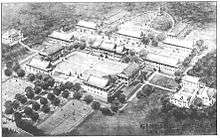Ginling College
| 金陵女子大学 | |
 Campus planning of Ginling College, by the architect Henry Murphy. | |
| Motto | 厚生 |
|---|---|
Motto in English | Public welfare |
| Type | Women's college |
| Established | 1913 |
Parent institution | Nanjing Normal University |
| Dean | Qian Qi Huan |
| Location |
Nanjing, Jiangsu, |
| Website |
ginling |
Ginling College (金陵女子大学), sometimes also known by its Pinyin romanization as Jinling College or Jinling Women's College, is a women's college of Nanjing Normal University in Nanjing, China. It offers both bachelor's and master's degrees.[1] It offers six undergraduate majors: applied English, accounting, financial management, labor and social welfare, food science and engineering, and food quality and safety. Master's degrees are offered in food science, agricultural products processing and storage, and women's education.[2]
Ginling College traces its roots to the Christian college of the same name founded in 1913, which started operations in 1915 and was the first institution to grant bachelor's degrees to female students in China. The school was closed from 1951 to 1987, when it was reestablished on its previous site.
American architect and art historian Talbot Hamlin designed some of the buildings that were constructed in the 1919 to 1925 period.[3]
Wu Yi-Fang, who was one of Ginling's first five graduates and earned a doctorate degree from the University of Michigan in 1928, became the first female college president in China, heading Jinling College from 1928-51 until it merged with the University of Nanking in 1951. Wu, who became a powerful figure in the People's Republic of China as a patriotic woman educator, worked tirelessly to reopen the school.[4] However, it did not ultimately reopen until 1987, two years after her death.
During the Nanking Massacre, the college, led by its acting principal Minnie Vautrin,[5] harbored over 10,000 women trying to hide from the Japanese Imperial Army.[6]
Legacy
- Nanjing Normal University was founded on the campus of Ginling College in 1952.
- Jinling Girls' High School(金陵女子高級中學) in Taipei was founded by alumnae of Jinling Women's University in 1956.
References
- ↑ Jin 2010, p. 247.
- ↑ "校史:从金女大到金女院". Ginling College. 2010-01-14. Retrieved 2014-12-29.
- ↑ http://library.columbia.edu/locations/avery/da/collections/hamlin_tf.html
- ↑ Jin 2010, p. 244-245.
- ↑ Chang, Iris, The Rape of Nanking: The forgotten holocaust of World War ll, Basic Books, A Subsidiary of Perseus Books, L.L.C., 1997 pp. 130-138
- ↑ Vautrin 2008, p. xxiv.
Works cited
- Feng, Jin (2010). The Making of a Family Saga: Ginling College. ISBN 9781438429120.
- Thurston, Matilda S. Calder; Chester, Ruth Miriam (1956). Ginling College.
- Vautrin, Minnie (2008). Terror in Minnie Vautrin's Nanjing: Diaries and Correspondence, 1937-38. University of Illinois Press. ISBN 9780252033322.
External links
- Official site (Chinese)
- Ginling Association in America
- Ginling College, Biographical Note at the Smith College Archives